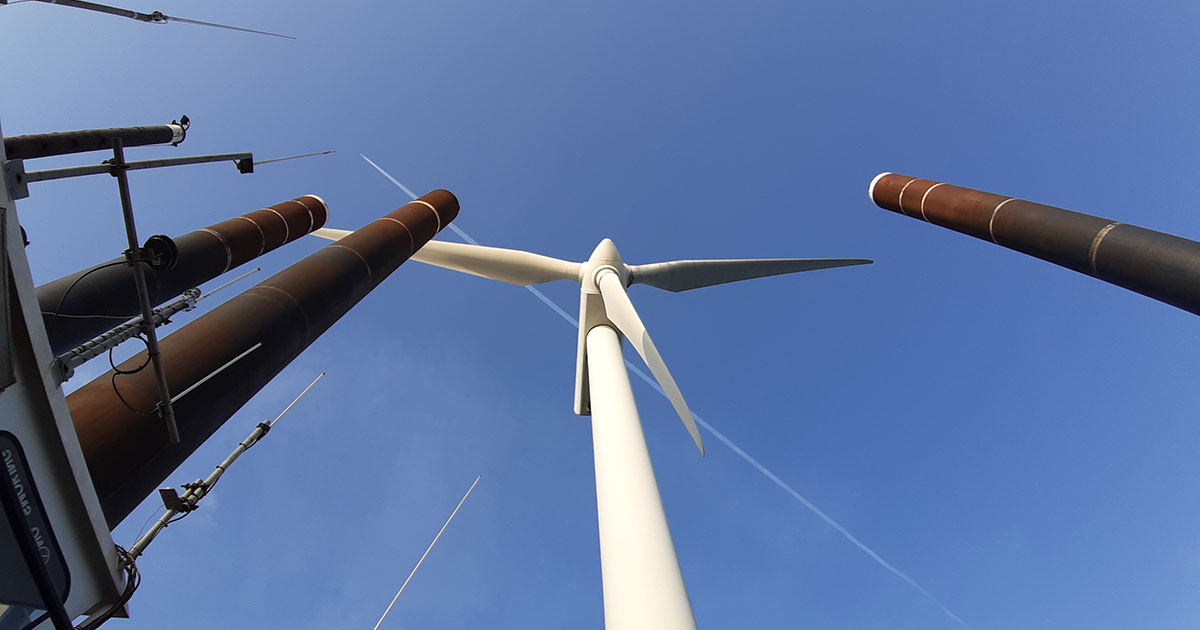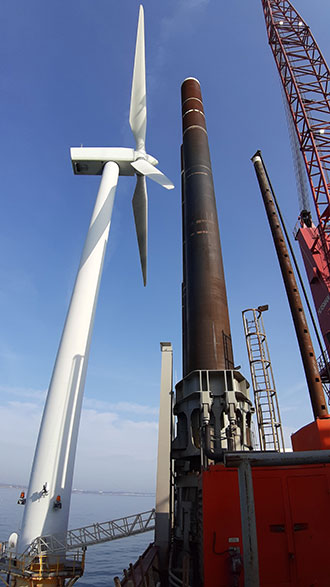Excalibur Supports Blyth’s Full Project Life Ccle

Despite only having two turbines, the Blyth Offshore Wind Farm had a big impact on the renewable energy industry. As the first offshore development in the UK, it demonstrated that wind power provided a robust, feasible, alternative energy source and heralded a new era of renewable technology.
 According to E.ON, now RWE Renewables, which owned and operated the wind farm, the turbines at Blyth generated enough energy to supply over 2000 homes, preventing 4520 tonnes of carbon dioxide from entering the atmosphere each year.
According to E.ON, now RWE Renewables, which owned and operated the wind farm, the turbines at Blyth generated enough energy to supply over 2000 homes, preventing 4520 tonnes of carbon dioxide from entering the atmosphere each year.
Full life cycle support
Back in 1998, Fugro conducted the overwater site investigation to inform the design of the monopile foundations for the pair of 2-megawatt wind turbine generators at Blyth. They returned two years later to drill and grout both the foundation piles, using their Excalibur jack-up platform.
After successfully generating electricity for nearly 20 years, by April 2019 the asset at Blyth had reached the end of its life cycle. Having helped bring the project to fruition, it’s fitting that Excalibur was again deployed to support the decommissioning. Returning to the site with Excalibur was a proud and memorable moment for the Fugro team.
A complex operation
Each of Blyth’s two generators was 95 metres high and mounted on a 3.5-metre diameter monopile fixed in a pre-drilled grouted socket. E.ON’s challenge was to remove the turbines safely and with minimal impact on the environment; the turbines would then be recycled. It was clear from the outset that this removal would be a complex operation, and the irregular seabed and ravines of sandstone outcrop at the site required a specialist and low-impact approach.
Fugro’s solution for minimising the environmental impact was based on Excalibur’s cruciform capped jacking legs, which ensure a highly mobile, light-footprint approach for work on wind turbines and cable arrays in nearshore areas and shallow transition zones.
Excalibur’s 230-tonne crane was deployed to decommission the two turbines and foundation structures. A robust technical solution was required to overcome not only the weight of the monopile foundations but also any embedment friction accumulated during the construction phase.
A load-bearing platform located on Excalibur’s existing aft moon pool reaction beams was central to Fugro’s solution. Jacking stools equipped with hydraulic cylinders exerting 600 tonnes of hydraulic lift were in position, poised to remove the monopile in a safe and controlled way, with minimal impact on the marine environment.
Fugro used a water-jetting tool to cut the structure 0.5 metres below the seafloor. The jack-up’s integral reaction beams were then used to lift the monopile free before transferring it to Excalibur’s deck and onward to recycling. The remaining socket was then filled to seafloor level with 250 tonnes of ballast stone to return the installation site to a natural condition.
Cable recovery
The next step was to disconnect and terminate a 1.4-kilometre length of heavy-duty electrical cable. Once it had been safely earthed and any residual current discharged, Fugro used a multicat vessel to winch the now-redundant cable onboard for eventual disposal.
Fugro deployed specialist equipment to recover the cable and varied their methods according to the topography: a mass-flow excavation tool was used to expose the cable where it ran through an offshore submerged sand bank; two 15-tonne 360° excavators were used where the cable lay in an intertidal location.
The operation went according to plan and Fugro’s flexible approach resulted in safe, efficient operations and full cable recovery.
Solution sets the benchmark
Fugro’s innovative offshore wind farm foundation jacking solution uses a safety-first approach, based on robust engineering and efficient operation, that mitigates the cost and deployment challenges of using bigger cranes and jack-up barges. It’s a ground-breaking solution that won the Innovation Showcase Award in the Renewable Energy category at the 2019 European Commercial Marine Awards.
Patrick Rainey, E.ON, now RWE Renewables Offshore Logistics Manager, was impressed: “The Blyth decommissioning brought its own set of unique challenges, just as it did when the turbines were constructed almost 20 years ago. The site’s proximity to shore and the fact that it was the UK’s first [offshore wind] decommissioning project generated a lot of interest, which added additional pressure for positive completion.
“I would like to thank Fugro: their expertise, professionalism and knowledge were key factors that enabled the successful on-time decommissioning of the UK’s first offshore wind farm without incident. As a result of Fugro’s work on this project, the benchmark has now been set for future decommissioning activities.”

